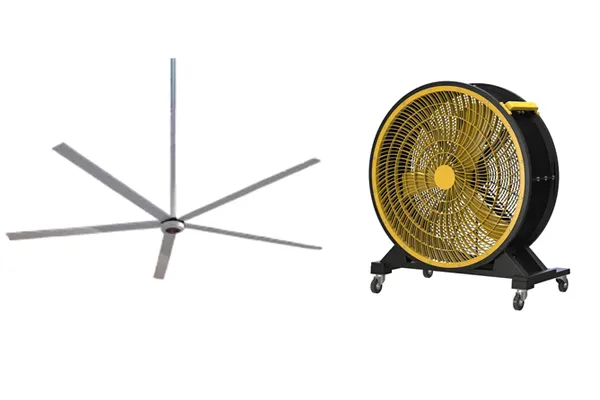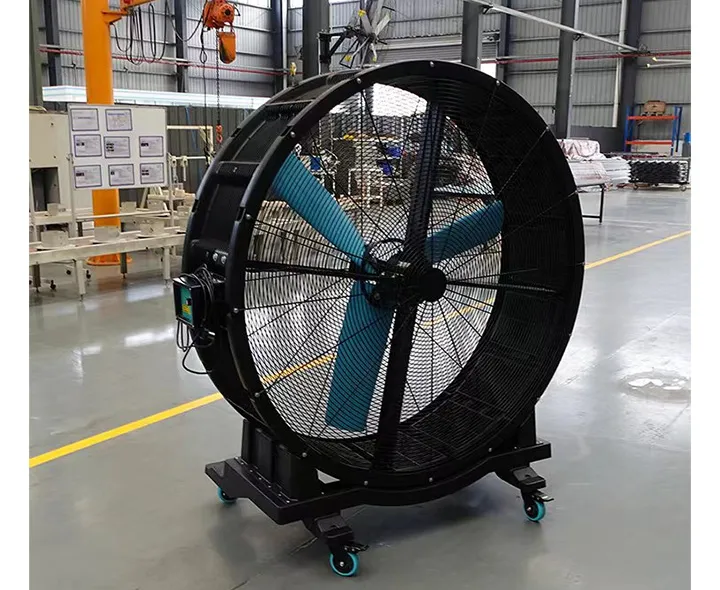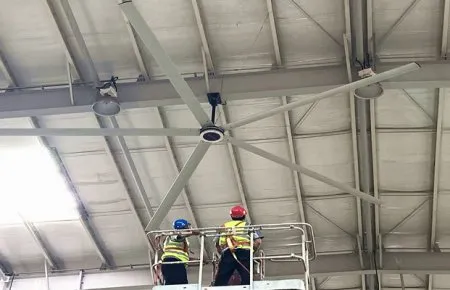Warehouses overheat, gyms get sticky, and 工厂 workers lose focus when stale air refuses to move. Pick the wrong fan and you burn cash on power; pick the right one and you slice costs while everyone feels 凉爽的 again.
一个 industrial floor fan delivers high‑velocity air exactly where people sweat, whereas an 工业天花板 unit mixes hot ceiling layers with cooler floor air for even 空气流动 穿过 更大的空间. Choose floor models for spot‑cooling; mount ceiling fans when whole‑room 空气流动 and lower energy bills matter most.

Industrial Floor Fan vs Industrial Ceiling Fan
Before we dive into numbers, understand the core contrasts:
Installation position – a floor model rests on rubber feet; a ceiling unit hangs from steel drop rods (mount fan style).
Air stream shape – floor designs act like a directional fan, firing a narrow jet that can oscillate if needed. Ceiling blades spread air in a wide column to 流通 every corner.
Typical output – floor units supply 5 000–8 000 立方英尺/分钟 in a tight beam; ceiling versions move 50 000 CFM +, gently blanketing aisles.
Noise levels – because their blades spin slower, ceiling products stay under 55 dB for quiet operation; floor units reach 70 dB but still meet OSHA acoustic limits.
Capital cost – on day one, a rugged floor model costs a few hundred dollars; an HVLS ceiling system costs more up front but often pays back in utility savings within two summers.
Tip: Always measure the 空气量 和 anemometer at the height your team works, not at the fan grill. That reading shows true comfort, not brochure hype.
一个 floor‑standing 鼓风机 shines in jobs that demand direct airflow right now:
Real‑world scenario
A 3 800 ft² 车库 servicing trucks had fume pockets near floor level. Two 24 inch floor fans on low 转速 moved 7 200 CFM each, cutting CO concentration by 40 % while staying within the shop’s modest breaker capacity.
Because they’re movable, floor units also relieve “hot spots” in pallet‑pick zones where 空调 just can’t keep up.

When to Choose an Industrial Floor Fan
If your roof sits higher than a basketball rim, heat stratifies. An overhead HVLS fan:
我们的 仓库超大节能风扇 deliver a gentle, high performance column that employees say “feels like a natural breeze rather than a draft.”
| Floor Area (ft²) | Target Air Changes | Required 立方英尺/分钟 | Fans Needed* |
|---|---|---|---|
| 5 000 | 6 per hr | 10 000 | 2 × 24 inch floor units |
| 20 000 | 4 per hr | 53 000 | 1 × 18 ft ceiling unit |
| 40 000 | 4 per hr | 106 000 | 2 × 18 ft ceiling units |
*Based on standardized specification sheets for our 工业风扇 lineup. Adjust counts for 排气 load or high humidity to stay at 最佳性能.
To compare payback, plug the watt draw into our free ROI sheet—the ceiling option often recovers its premium within 18 months thanks to lower kWh.
Fan blades spinning at high‑speed can be an asset or a danger—it depends on compliance:
Quick check: If the site handles solvents and requires 24/7 airflow, install an interlock so the fan trips when the exhaust system fails—smart safety and smart insurance.
Maintenance math: A ceiling unit sees half the service visits of comparable pedestals, saving crews roughly $600 per fan across five years.

安装与维护
The client: a regional sports center with a 12 m‑high basketball court attached to a 370 m² truck 车库. Summer temps peaked at 33 °C, equipment rusted, and the HVAC ran nonstop.
Solution
| Metric | Before retrofit | After retrofit | % Change |
|---|---|---|---|
| Avg Floor Temp (°C) | 33 | 27 | –18 % |
| Relative Humidity | 78 % | 55 % | –23 % |
| 每日千瓦时 | 780 | 580 | –26 % |
| Worker Complaints | 14/mo | 3/mo | –79 % |
Insights
The ceiling fan blended stratified air; the floor units delivered direct airflow to mechanics during peak heat bursts. Payback arrived in 15 months purely from reduced chiller runtime.
Run through these eight checkpoints and circle the first column that fits—your answer tells you which fan wins:
天花板高度
Layout flexibility
Cooling needs
Noise tolerance
Safety zone
Budget horizon
占地面积
Maintenance staff
Finish with more ticks on one side? That’s your best fit. Still unsure? Our engineers will size fans free of charge—no obligation.
Do I need both a ceiling fan and floor units for a 50 000 ft² plant?
Often yes. A big HVLS mixes the air column, and two 24‑inch floor blowers deliver direct airflow at conveyor chokepoints for the most comfortable cooling experience.
Is a Lasko ‘fan 20’ sufficient for industrial use?
Consumer lines like Lasko excel in garages, but production floors demand rugged steel cages, sealed bearings, and higher 立方英尺/分钟. Step up to our 20‑inch 高速风扇 rated 5 500 CFM for powerful performance beyond hobby work.
Can floor models meet OSHA when they oscillate?
Yes. Our adjustable heads lock securely; the guard spacing meets §1910.212. Always keep 7 ft clearance when you oscillate toward personnel pathways.
How do I integrate fans with building ventilation?
Tie 变速 drives to a CO sensor; when exhaust levels spike, the controller ramps fans to boost 通风 and signal make‑up air units—smart, safe, and fully programmable.
What if my facility is partially outdoor?
Select an outdoor rated IP55 floor fan; stainless screws and UV‑stable grills shrug off rain. Ceiling units get epoxy‑powder blades for durable service on loading docks.
Will the fans interfere with air‑conditioning ducts?
No. Properly sized HVLS blades spin just 60–80 转速—slow enough to cooperate with diffusers and actually improve duct throw by reducing thermal layering.
As a hvls fans manufacturing plant, we control every step—from rotor die‑casting to final balance on laser rigs. Each line leaves our ISO‑9001 shop with:
Ready to upgrade? Our team tailors solutions to your 具体需求—reach out today for a no‑cost airflow audit and watch productivity soar.